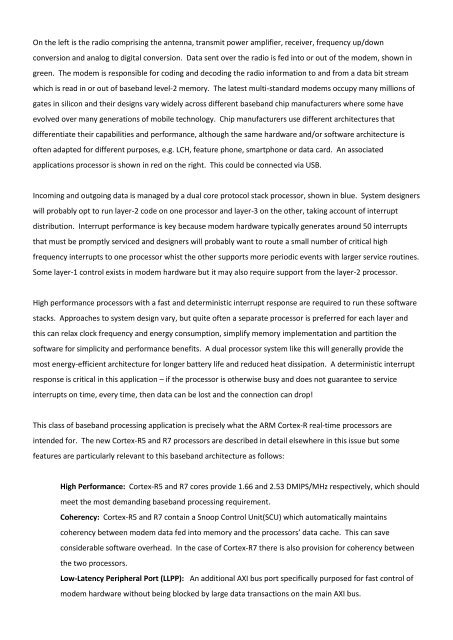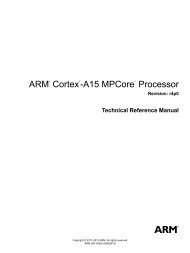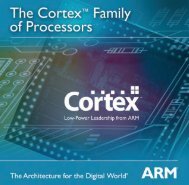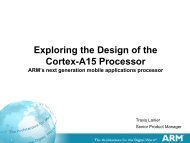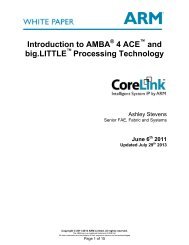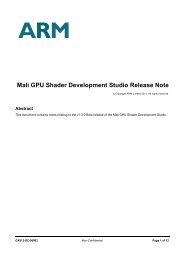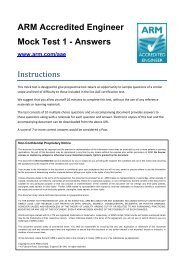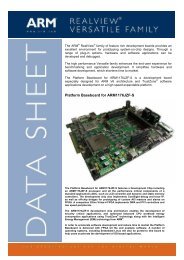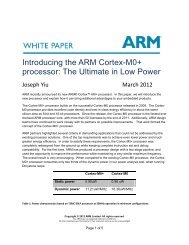New Cortex-R Processors for LTE and 4G Mobile Baseband - ARM
New Cortex-R Processors for LTE and 4G Mobile Baseband - ARM
New Cortex-R Processors for LTE and 4G Mobile Baseband - ARM
- No tags were found...
Create successful ePaper yourself
Turn your PDF publications into a flip-book with our unique Google optimized e-Paper software.
On the left is the radio comprising the antenna, transmit power amplifier, receiver, frequency up/downconversion <strong>and</strong> analog to digital conversion. Data sent over the radio is fed into or out of the modem, shown ingreen. The modem is responsible <strong>for</strong> coding <strong>and</strong> decoding the radio in<strong>for</strong>mation to <strong>and</strong> from a data bit streamwhich is read in or out of baseb<strong>and</strong> level-2 memory. The latest multi-st<strong>and</strong>ard modems occupy many millions ofgates in silicon <strong>and</strong> their designs vary widely across different baseb<strong>and</strong> chip manufacturers where some haveevolved over many generations of mobile technology. Chip manufacturers use different architectures thatdifferentiate their capabilities <strong>and</strong> per<strong>for</strong>mance, although the same hardware <strong>and</strong>/or software architecture isoften adapted <strong>for</strong> different purposes, e.g. LCH, feature phone, smartphone or data card. An associatedapplications processor is shown in red on the right. This could be connected via USB.Incoming <strong>and</strong> outgoing data is managed by a dual core protocol stack processor, shown in blue. System designerswill probably opt to run layer-2 code on one processor <strong>and</strong> layer-3 on the other, taking account of interruptdistribution. Interrupt per<strong>for</strong>mance is key because modem hardware typically generates around 50 interruptsthat must be promptly serviced <strong>and</strong> designers will probably want to route a small number of critical highfrequency interrupts to one processor whist the other supports more periodic events with larger service routines.Some layer-1 control exists in modem hardware but it may also require support from the layer-2 processor.High per<strong>for</strong>mance processors with a fast <strong>and</strong> deterministic interrupt response are required to run these softwarestacks. Approaches to system design vary, but quite often a separate processor is preferred <strong>for</strong> each layer <strong>and</strong>this can relax clock frequency <strong>and</strong> energy consumption, simplify memory implementation <strong>and</strong> partition thesoftware <strong>for</strong> simplicity <strong>and</strong> per<strong>for</strong>mance benefits. A dual processor system like this will generally provide themost energy-efficient architecture <strong>for</strong> longer battery life <strong>and</strong> reduced heat dissipation. A deterministic interruptresponse is critical in this application – if the processor is otherwise busy <strong>and</strong> does not guarantee to serviceinterrupts on time, every time, then data can be lost <strong>and</strong> the connection can drop!This class of baseb<strong>and</strong> processing application is precisely what the <strong>ARM</strong> <strong>Cortex</strong>-R real-time processors areintended <strong>for</strong>. The new <strong>Cortex</strong>-R5 <strong>and</strong> R7 processors are described in detail elsewhere in this issue but somefeatures are particularly relevant to this baseb<strong>and</strong> architecture as follows:High Per<strong>for</strong>mance: <strong>Cortex</strong>-R5 <strong>and</strong> R7 cores provide 1.66 <strong>and</strong> 2.53 DMIPS/MHz respectively, which shouldmeet the most dem<strong>and</strong>ing baseb<strong>and</strong> processing requirement.Coherency: <strong>Cortex</strong>-R5 <strong>and</strong> R7 contain a Snoop Control Unit(SCU) which automatically maintainscoherency between modem data fed into memory <strong>and</strong> the processors’ data cache. This can saveconsiderable software overhead. In the case of <strong>Cortex</strong>-R7 there is also provision <strong>for</strong> coherency betweenthe two processors.Low-Latency Peripheral Port (LLPP): An additional AXI bus port specifically purposed <strong>for</strong> fast control ofmodem hardware without being blocked by large data transactions on the main AXI bus.


